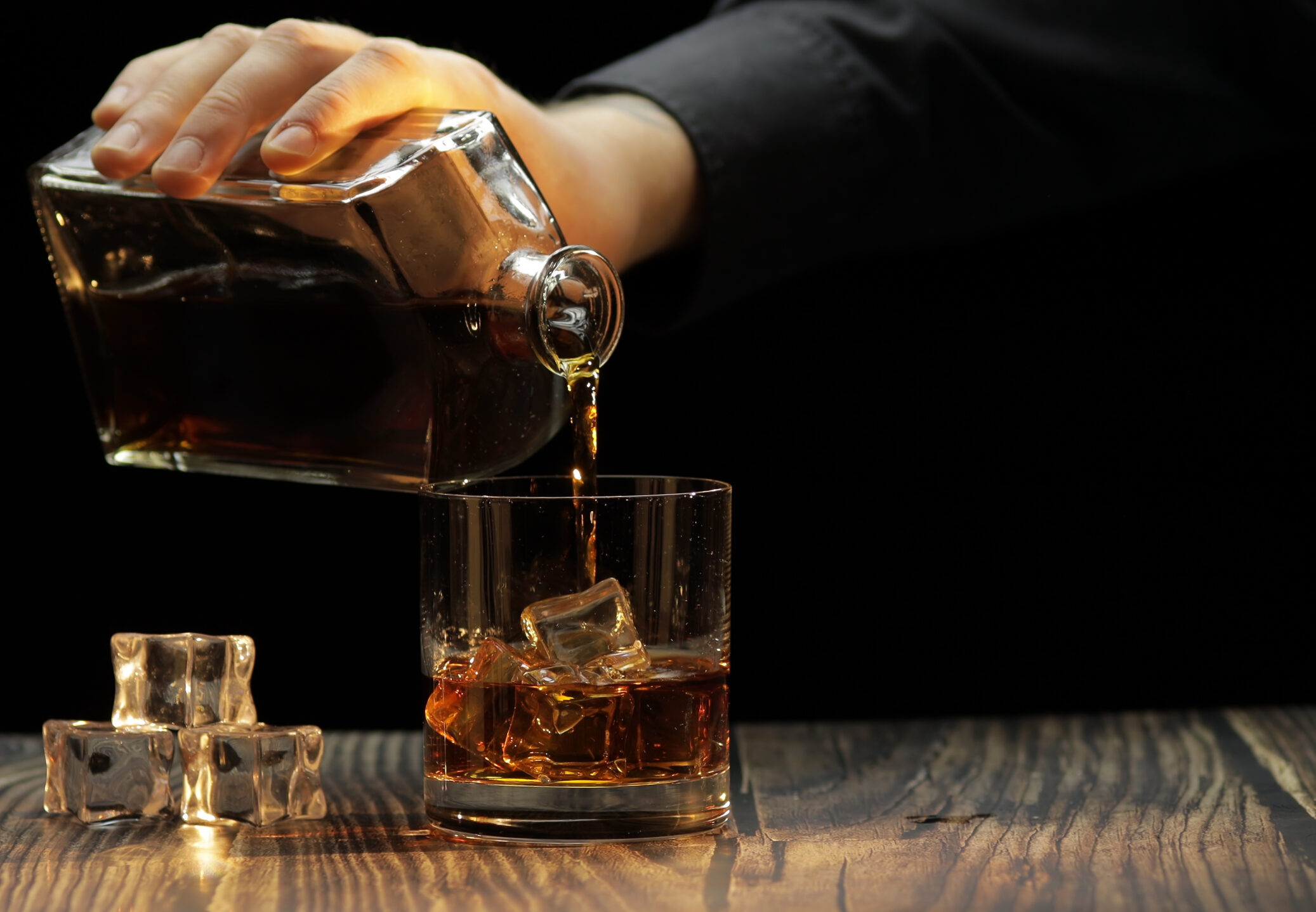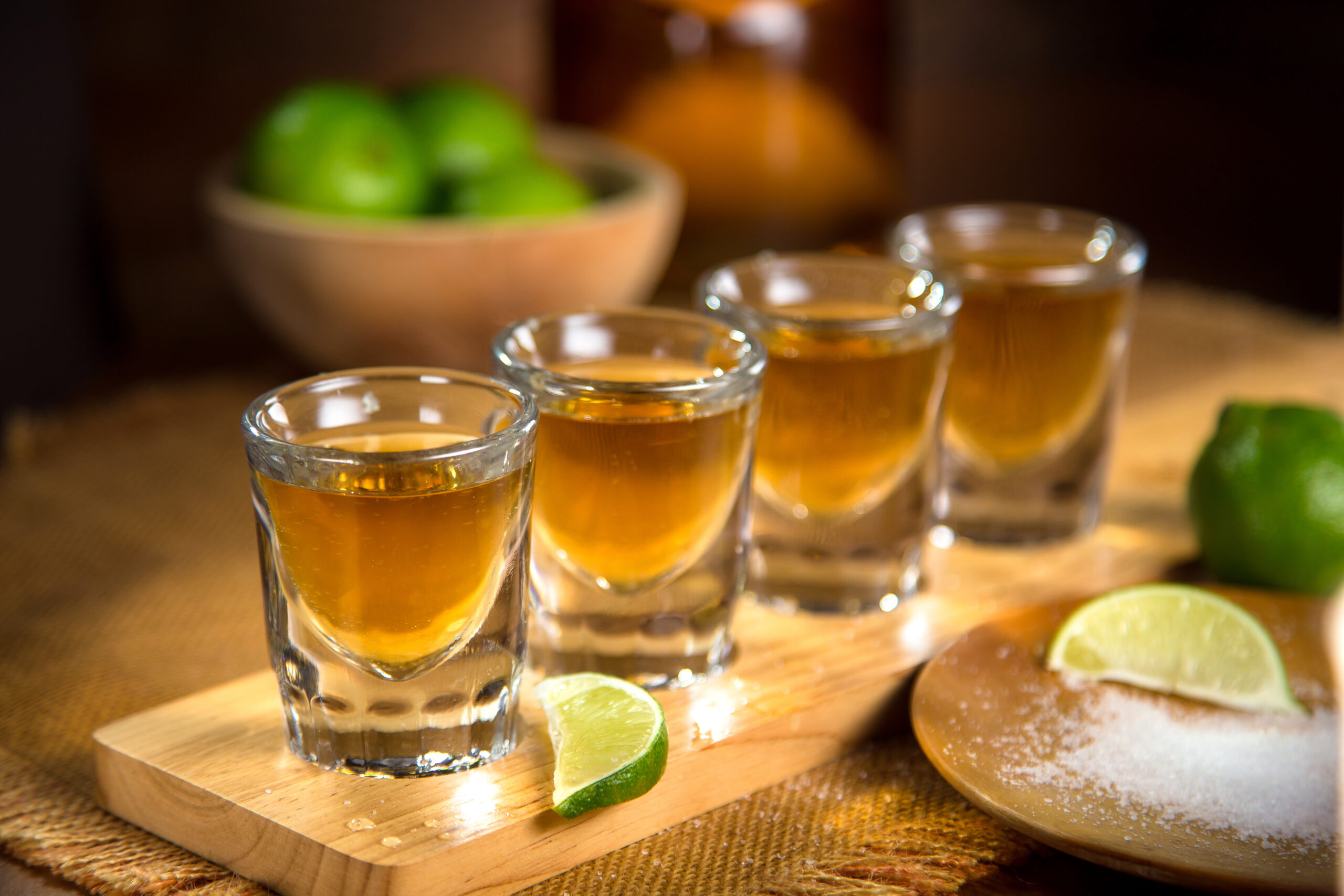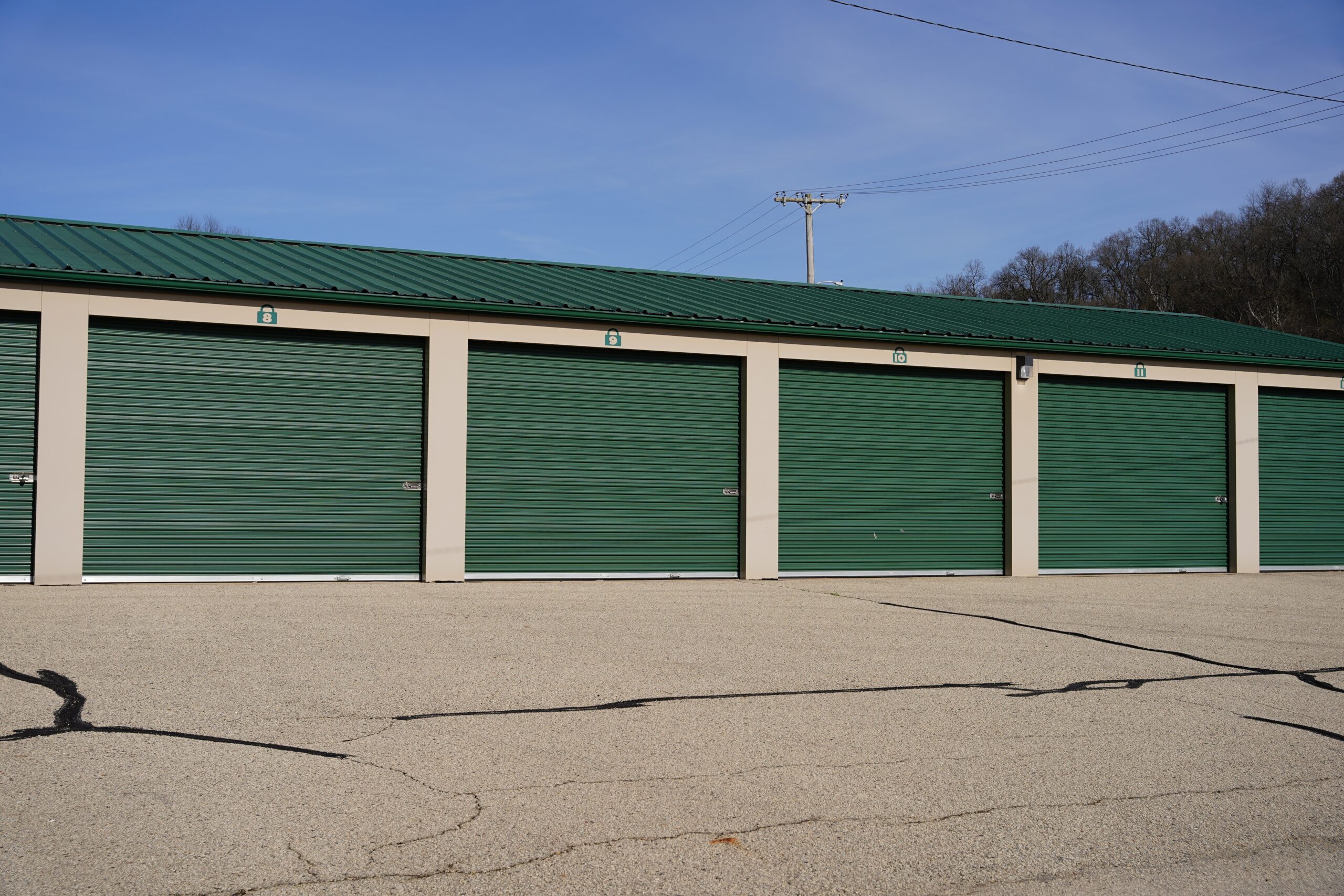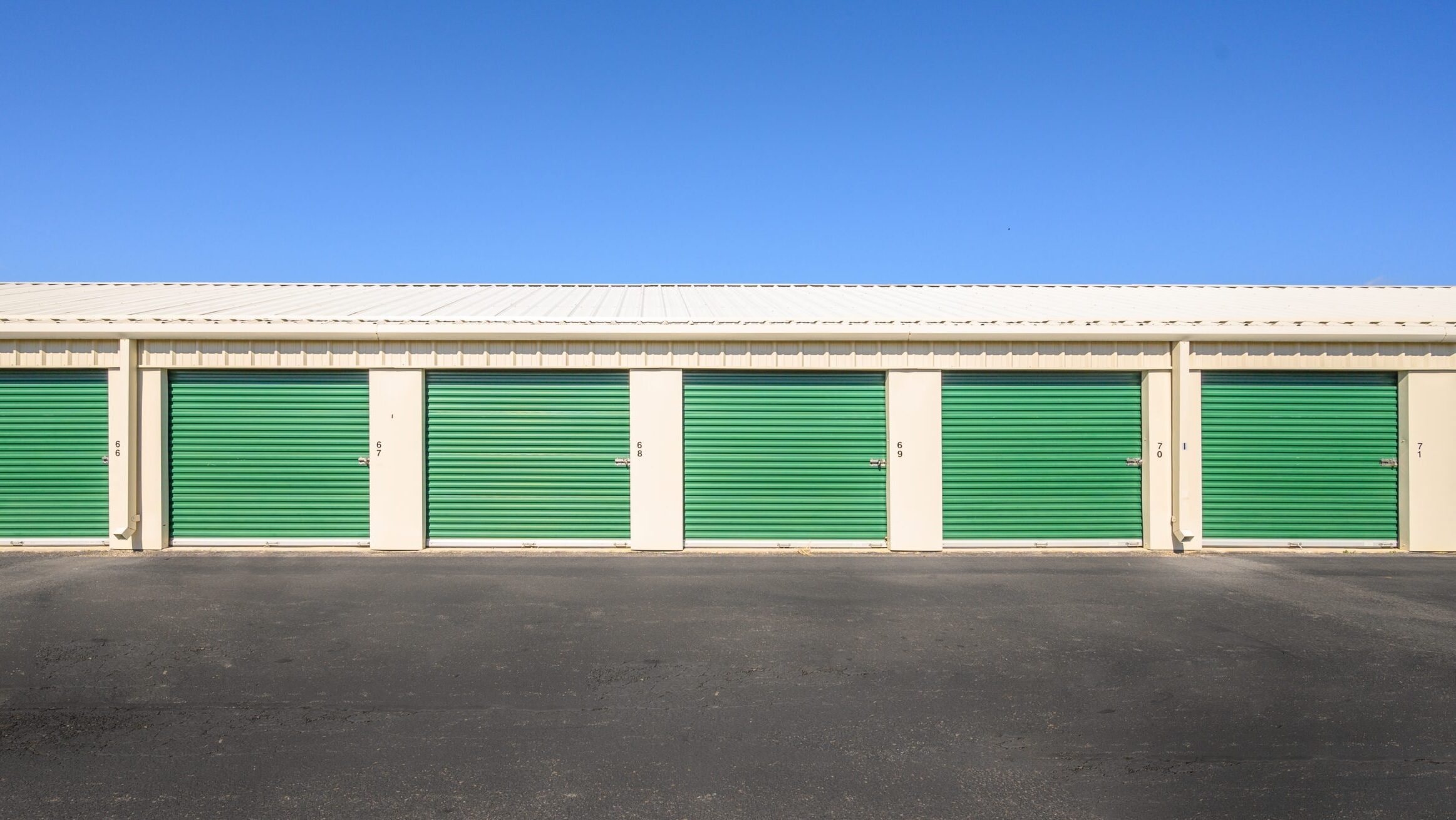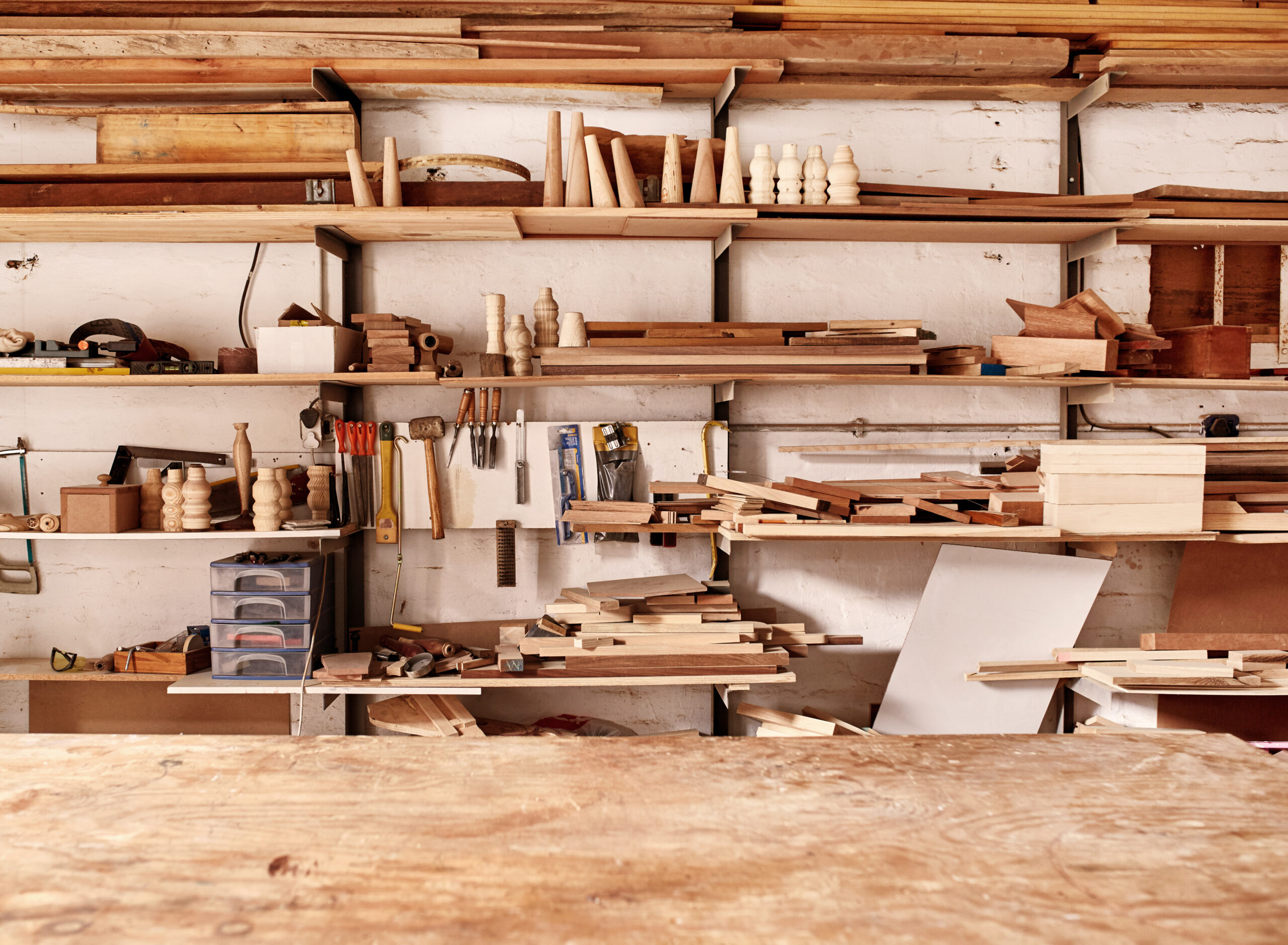Article takeaways
- Store whiskey at a consistent temperature between 59°F and 65°F in a dark room to avoid UV rays and temperature fluctuations that break down the chemical compounds, turning premium bottles into flat-tasting spirits regardless of their original quality and price.
- Whiskey should be stored in humidity levels of 50-70% to prevent cork deterioration – humidity under 40% dries out corks, while humidity close to 80% promotes mold growth and label damage.
- Unlike wine, whiskey should never be stored on its side, or the high alcohol content can corrode the cork, allowing air to enter and oxidize the spirit while also contaminating the whiskey with cork particles.
- Once opened, whiskey maintains its flavor if stored properly and kept at least two-thirds full. When the bottle drops below 25% full of liquor and is 75% air, oxidation accelerates rapidly, and the flavor starts to degrade.
- For serious collectors or businesses, climate-controlled storage units provide consistent temperature, humidity control, light protection, and security features that preserve whiskey quality better than most home storage options.
When it comes to toasting the finer moments of life, there’s nothing like a glass of high-grade whiskey.
From peaty, smoky Scotch to rich, floral Japanese whiskey to sweet, vanilla-esque Irish Whiskey to bold and buttery Tennessee and Kentucky bourbons, quality whiskey presents a diverse range of flavors for any special occasion.
Even within the culture and region of origin, whiskey comes in a variety of flavor profiles that only ripen with age.
That said, improper whiskey storage methods can evaporate the differences between a $20 bottle and a $500 bottle.
And if you’re like me, the days of putting down an entire bottle of blended bourbon are far behind you. These days, I’m more interested in savoring the sips of quality whiskey to enhance the essential joy of my present company.
Maybe we’re corking an opened bottle of Scotch once the glasses are topped off. Or perhaps we’re setting a sealed bottle of bourbon aside for a future celebration. Either way, we need to know the basics of how to store whiskey.
And if you’re a bartender or bar owner looking to store cases on cases of whiskey, the whiskey storage ideas you employ need to preserve the flavor of every bottle equally.
This helpful guide will explain how to store whiskey in detail. We’ll dive into whiskey storage ideas that are suitable for short-term and long-term whiskey storage. We’ll explain how to store your personal whiskey collection and how to store your bar or restaurant’s whiskey inventory without it losing flavor.
Finally, how climate-controlled self-storage can make the ideal whiskey storage solution, and how to use our Storage.com search tool to find an ideal yet affordable whiskey storage unit near you.
Whiskey Storage Basics
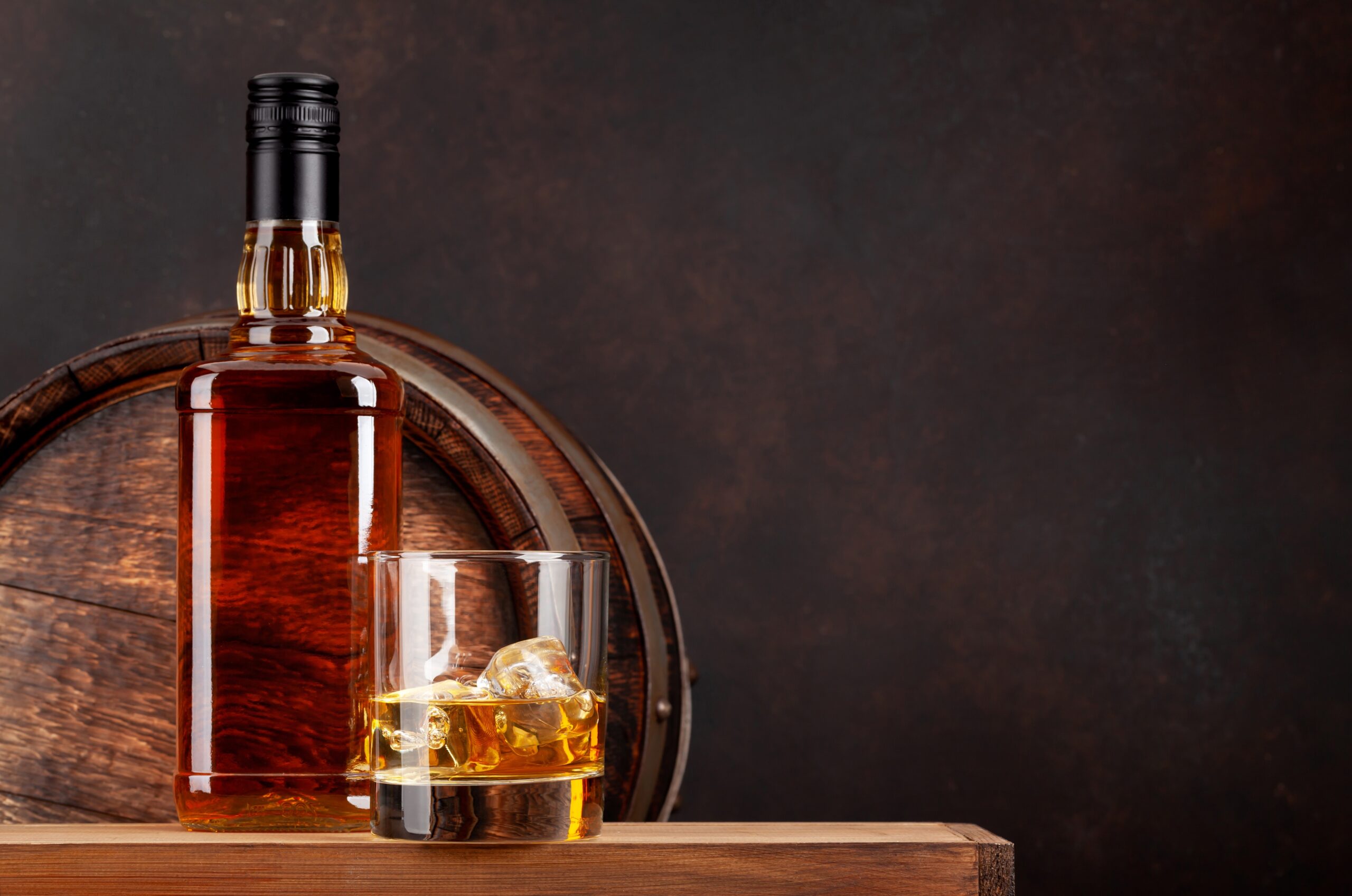
As we mature, so do our drinking habits. Eventually, as our tastes refine, we get to the point of accumulating bottles of quality whiskey faster than we can consume them. Before we get into our expert whiskey storage ideas, let’s take a look at the science behind proper whiskey storage.
What’s the Science Behind Proper Whiskey Storage?
An adequately sealed bottle of whiskey will hold for over a hundred years. Case in point, the famous account of Ernest Shackleton’s whiskey bottle, reported on here by angelsenvy.com:
“When the Antarctic explorer Ernest Shackleton’s whisky was recovered from his hut on Ross Island in 2007, a century after his 1908 Nimrod expedition, it was, by all accounts, still delicious.”
That said, a sealed bottle of whiskey will only hold its flavor if it is stored properly, protected from ultraviolet rays and direct sunlight, and kept safe from drastic temperature changes. An open whiskey bottle is even more vulnerable to losing its flavor. Let’s take a look at the science of both, starting with that of an unopened whiskey bottle.
The Science Behind Whiskey Storage: Sealed Bottles
- In the case of a properly sealed bottle of whiskey, the bottle will hold its character for decades as long as it’s kept out of sunlight and at a consistent holding temperature.
- Ultraviolet rays can cause chemical reactions, initiating the breakdown of your whiskey’s flavor by degrading the esters, or chemical compounds, responsible for the whiskey’s distinct flavor.
- Temperature fluctuations cause the liquid to expand and contract, which also impacts the chemical composition of the bottle, altering the flavor of he whiskey.
- If the bottle is indeed sealed properly, the proof or alcohol potency of the liquor will be unaffected.
- So, the whiskey will be safe to drink, and will have the same intoxicating effect, but the flavor will be much flatter or harsher than what you paid for.
In short, even if your fancy bottle of whiskey is still sealed, it needs to be kept out of direct light, fluctuating temperatures, and humidity levels.
A whiskey cabinet in your living room or kitchen may keep your spirits safe from sunlight. But temperature and humidity-controlled basements, cellars, and storage units will hold the consistent temperatures needed for long-term whiskey storage while preserving the flavor of the sealed bottle of whiskey.
The Science Behind Whiskey Storage: Opened Bottles
Once you open the bottle, the countdown to flavor loss begins. It’s a slow countdown, however – it takes much longer for good whiskey to turn than it does for wine. Again, reviewing the science will help us make informed choices when it comes to whiskey storage ideas.
- If the opened bottle of whiskey is at least two-thirds full and stored out of direct sunlight, it will keep its original flavor for at least a year.
- Just like with a sealed bottle, an opened whiskey bottle exposed to UV rays and light will not only lighten in color, but also harshen the flavor.
- Light will break down the whiskey’s molecular composition just like with a sealed bottle. The difference is that with an open bottle, sunlight can also cause evaporation, causing the alcoholic proof and flavor to diminish in potency.
- And once you drink your whiskey down past the two-thirds full mark, the bottle’s air-to-spirit ratio starts to lean more towards air, meaning the bottle has more air in it than whiskey.
- More air accelerates the oxidation process; once the bottle is only 25% full of whiskey, oxidation will set in, and the flavor will start to degrade more rapidly.
Oxidation is the same process that causes rust on metal. The “empty” portion of the bottle isn’t empty at all; it’s full of air. And air is full of oxygen. The oxygen bonds with the whiskey molecules.
To prevent oxidation from impacting the flavor of your quality whiskey, you can put the whiskey into a small, airtight mason jar once it hits the halfway full mark. You can buy air-tight sealing caps for your whiskey bottles that are more effective than corks or screw tops.
Or, you can bring your whiskey to a dinner party and share it with some friends while it still boasts an impressive flavor profile.
Before we move into how to store whiskey without letting light and oxidation hurt it, let’s debunk a few myths about whiskey storage.
Debunking Common Whiskey Storage Myths
Here are popular assumptions surrounding whiskey storage that are worth debunking with facts, as we learn how to store whiskey properly:
| Whiskey Storage Myth | Why It’s False |
|---|---|
| FALSE: Whiskey continues to age in the bottle. | Whiskey’s flavor profile stops aging once it’s bottled and sealed. While wine can engage with oxygen through the glass or the cork in a way that continues to ripen its flavor profile, whiskey does not. |
| FALSE: We should store whiskey bottles on their sides like wine. | Whiskey has a much higher alcohol content than wine. When you store it on its side, the liquid will erode the cork, allowing oxygen to enter and cork particles to degrade the whiskey’s flavor. |
| FALSE: Freezing whiskey holds or improves its flavor. | Freezing a sealed bottle of whiskey won’t necessarily damage the spirit’s flavor, but it serves no purpose. That said, when you drink cold whiskey, the low temps dull your palate, weakening your ability to pick up the complexity of the flavors and scents. |
| FALSE: Sunlight changes the color of the whiskey but not the flavor. | Ultraviolet rays degrade the chemical compounds and change the molecular composition of whiskey, not only changing its color but also its flavor. |
| FALSE: Whisky spoils once it’s opened, like wine. | An open bottle of whiskey can last for years if it’s stored properly. Again, whiskey has more alcohol than wine, which preserves its integrity. That said, once there’s more air than liquid in the bottle, the flavor will start to change, even though the whiskey won’t spoil. |
How to Store Whiskey at Home
When it comes to storing your whiskey collection at home, we’re probably only talking about a handful of bottles, which means your storage solution requires less space. That said, depending on your living situation, you may have fewer options to choose from than those storing whiskey in a professional setting. Let’s take a look at how to store whiskey at home.
Creating the Perfect Home Whiskey Storage Environment
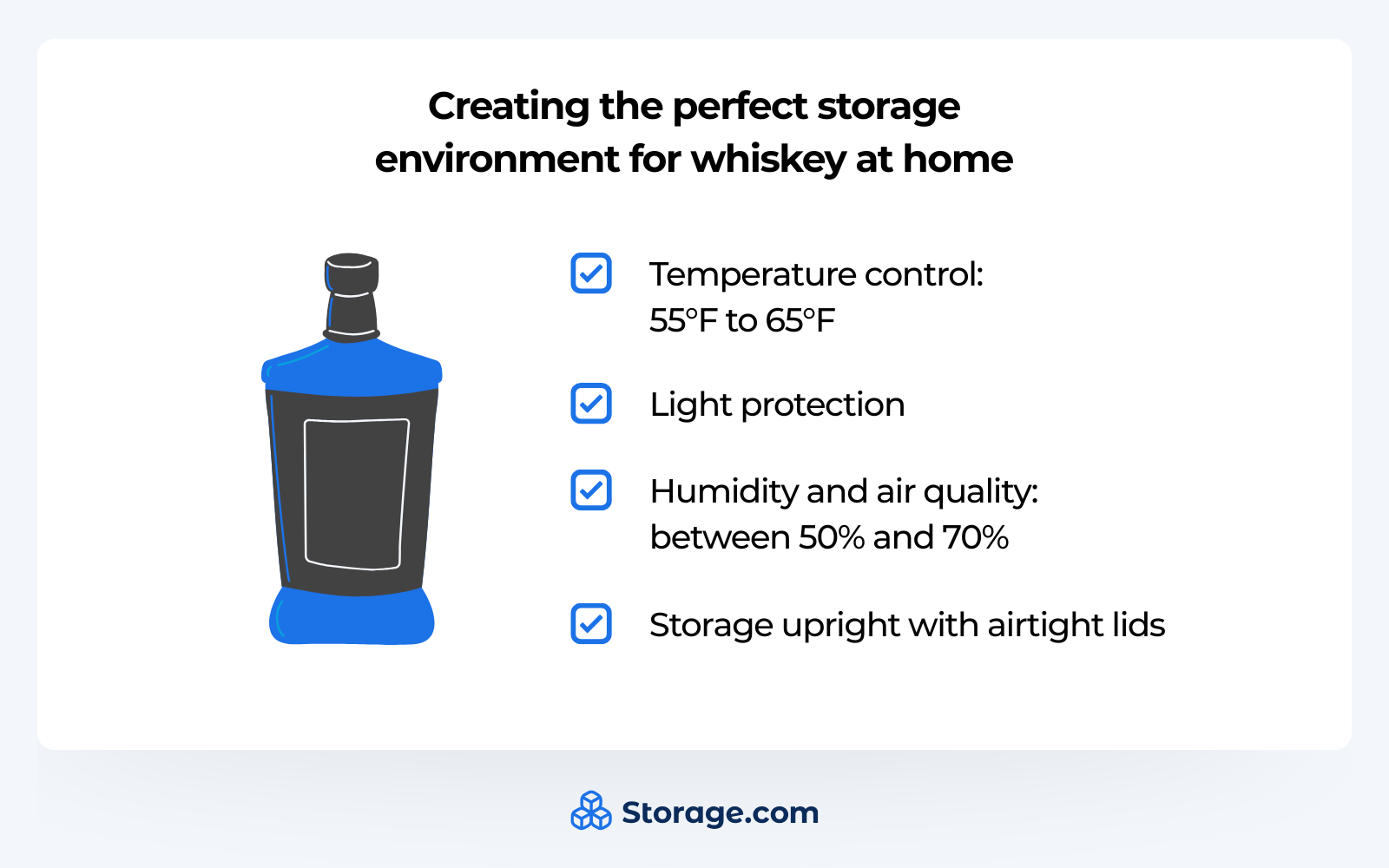
Storage position and containers, humidity and air quality, light protection, temperature control.
Temperature Control
Preserving the freshness, flavor, and overall quality of your whiskey starts with storing it at a consistent temperature. The ideal temperature range for whiskey storage is 55°F to 65°F. Any higher or lower than that, and the whiskey will start to evaporate, losing flavor.
Temperature fluctuations are even worse than storing it in the cold. As the temperatures rise and fall, the whiskey expands and contracts, degrading the chemical makeup of the whiskey. You’ll know the flavor changed when you come back ot the bottle and the color has dulled.
If you have the space, you can buy a wine cooler or small fridge for your whiskey collection, keeping it right around 59-70 degrees.
If a wine cooler or small fridge isn’t an option due to limited space, you can keep it in the coldest part of the house, such as in a cool basement, away from stoves and radiators. Or maybe you can fit a wine cooler in your off-site storage, as long as you have a garage, shed, or storage unit with electricity.
Light Protection
As we’ve mentioned a few times now, protection is essential for proper whiskey storage, since UV rays can destroy the molecular structure of your spirits, killing their flavor. A dark place, like a whiskey cabinet, a cupboard, or a closet, protects the whiskey from light exposure.
If you don’t have a cupboard at home, keep the whiskey bottle in the original box it came in.
Maybe the original carton it came in is ripped or doesn’t keep the light out, or your bottle didn’t come in a box. If that’s the case, wrap it in packing paper or tin foil and keep it in a room with no windows, or out of direct sunlight.
If you aim to display your fancy spirits, buy a whiskey display case designed to keep UV rays off the bottles, and display them so the bottles aren’t touching.
Again, when you come back to whiskey that has been stored out in the open and exposed to light, check the color. If the color has dulled, so have the flavors.
Humidity and Air Quality
It’s not just temperature that factors into whiskey preservation; it’s the humidity quality of the air. The optimal humidity levels for your whiskey storage room are between 50% and 70%.
Humidity under 40% can dehydrate the whiskey bottle’s cork. Once the cork is dry and brittle, it lets air into the bottle, raising the chances of that oxidation we mentioned earlier.
If the humidity gets close to 80%, mildew growth can degrade the bottle’s label, decreasing its value. And when it comes to the actual quality of your whiskey, high humidity can cause mold growth on the cork. If the cork deteriorates past a certain point, air can get into the bottle and oxidize the whiskey.
You can stop the cork from deteriorating by choosing a whiskey storage room equipped with climate control. Climate control is more than just heat in the winter and AC in the summer. For example, a climate-controlled storage unit uses humidity monitoring and control systems to keep humidity levels between 45% and 55%, perfect for whiskey storage.
Storage Position and Containers
Whiskey will last a lot longer if you store it in the upright position. It’s true that we store wine bottles on their sides, horizontally. In the case of wine, the liquid touching the cork actually serves to hold the seal by lubricating the cork.
But whiskey has a much higher alcohol content than wine. The reason experts suggest storing whiskey upright is that if whiskey were to splash against the cork, it would erode the cork. This not only lets air sneak past and oxidize the whiskey, but the deteriorating cork also contaminates the flavor of the whiskey.
You can store whiskey bottles upright, in their original boxes, in a cabinet or pantry. Speaking of catering and serving setups, you may be wondering when to store whiskey in a decanter.
Decanters are the glass or crystal serving vessels you see in the movies, with a glass lid that functions like a cork.
You can store whiskey decanters short-term. But since decanter lids don’t provide an airtight seal, a decanter full of whiskey should be treated as an open bottle of whiskey. We don’t suggest decanters for long-term whiskey storage, because the decanters themselves don’t seal.
If you need to store whiskey long-term, and you’ve already opened the bottle, we suggest either keeping it in the original bottle with a special airtight lid designed to keep liquor fresh for long-term whiskey storage.
You can also pour it into mason jars that seal with air-tight lids, using smaller jars so there’s no room for air. The fuller the storage container is, the longer the whiskey will hold its original flavor.
How to Store Whiskey in Large Quantities for Businesses
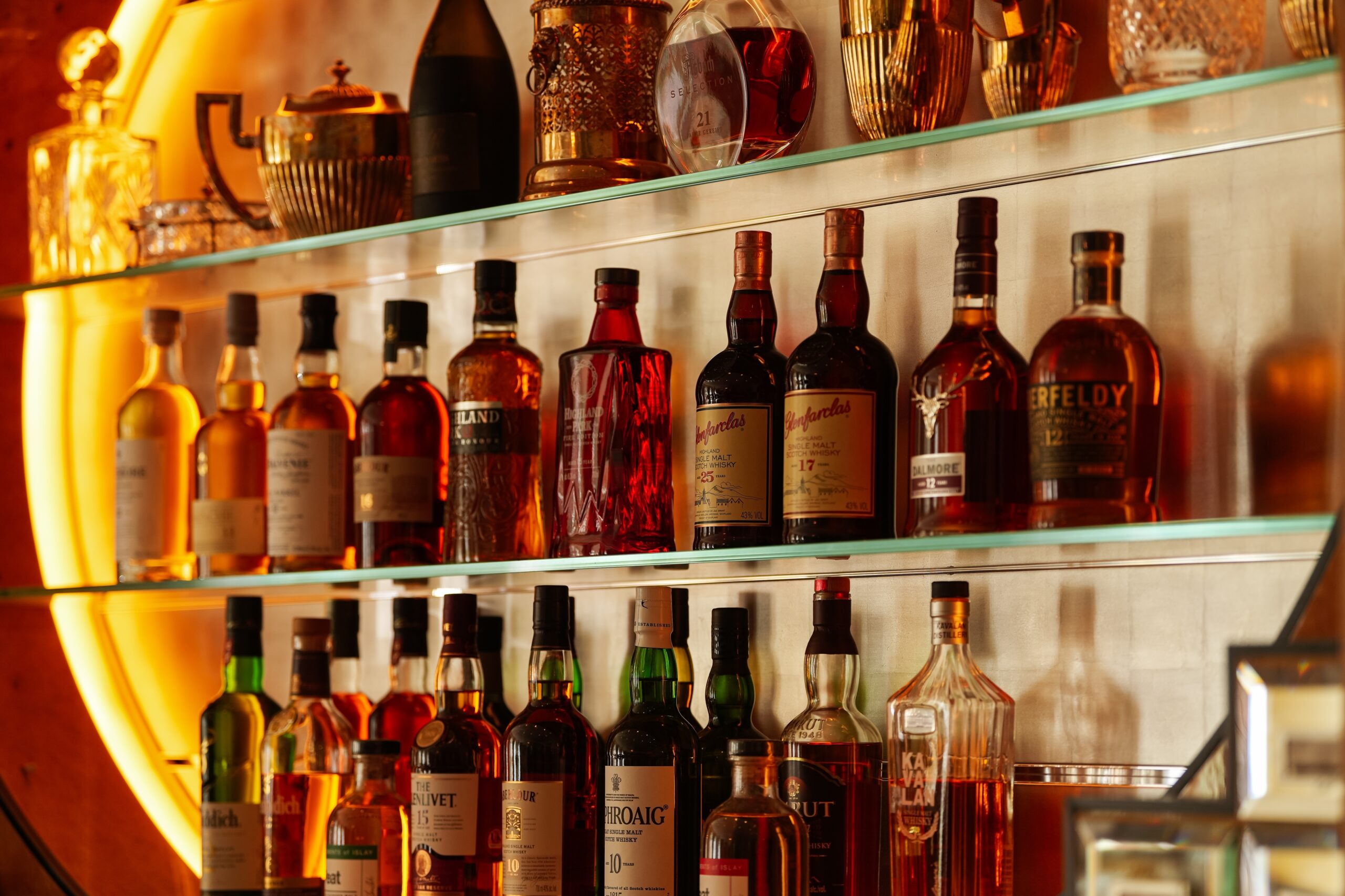
All the science that applies to storing your personal whiskey collection also applies to storing your inventory. Sealed bottles of whiskey will last for decades if they’re kept out of direct UV rays and light exposure.
Whiskey Storage Solutions for Bartending Professionals
Storing opened bottles of whiskey in a professional setting depends on the environment. Let’s take a closer look at how to store whiskey in some of the most common service industry whiskey storage scenarios.
Traveling Bartenders
For traveling bartenders wondering how to store whiskey, you’ll want to be sure you use portable storage cases that are completely dark to keep the light out. We suggest packing the travel cases with insulation that keeps them cool while stabilizing the bottles and keeps them from breaking.
They also make hard-cased portable storage containers that are insulated like a cooler, designed to hold the spirits at the temperature they were at when you put them in them.
At the very least, store the whiskey bottles in their original cases, with the cardboard dividers inserted. The boxes will keep them dark, and the dividers will keep the bottles from crashing into each other. You also need ot maintain the label’s integrity to follow liquor law protocols.
If you transport your whiskey backstock in its original box, we suggest keeping the transport vehicle between 59 and 70 degrees. You’ll have to check the state laws of the area you’re traveling through to find out if you’re able to travel with any leftover open bottles, but we don’t suggest it.
Regardless of the technique you employ, the primary concerns for whiskey storage travel are maintaining a consistent and cool temperature and protecting the whiskey from harsh light.
Caterers and Event Professionals
When it comes to how to store whiskey between catering events, you’ll likely need to get a much larger inventory organized into catering storage. We suggest keeping all your inventory in the cases it came in. Remember, a consistent temperature is key.
You’ll want to create a dark storage space for during the event that sits between 59 and 70 degrees. You could use a temperature-controlled transport case or a trailer that runs off a generator.
Between events, keep the liquor in a climate-controlled storage unit or warehouse with humidity control. Only open one bottle at a time, as your sealed bottles will stay flavorful for decades if they’re kept out of the light at a cool and consistent temperature.
You can use digital inventory management tools to expedite your whiskey inventory tracking system. Software and apps like MarketMan, BlueCart, or PeachWorks will tie into your POS system and track your liquor inventory in real time and prompt you to order when your inventory hits a certain point, long before the risk of running out.
Or you can use the old-fashioned pen and paper method to keep track of your bottles and sales. Either way, you’ll have to measure your pours and be precise to know exactly how much whiskey you go through per drink.
Whether you decide to go digital or analog, we suggest taking inventory of all your whiskey once you get back to your storage unit to make sure your inventory is accurate, adjusting your management techniques accordingly. Remember, most state laws expect you to keep track of all your liquor at all times.
Restaurant and Bar Storage
Restaurant and bar storage is similar to catering and event inventory storage, except restaurants typically go through liquor at a slower rate than a catering event with a busy bar cranking out drinks non-stop.
Bars may go through some bottles of whiskey more quickly than others, depending on the drink specials and the rotating clientele. Keeping bar and restaurant whiskey fresh requires vigilantly following a First-In-First-Out rotation system where you’re only opening one bottle of whiskey at a time.
You’ll have to employ an efficient open bottle whiskey storage system, keeping your open bottles away from light and humidity. Once the bottle gets to the 25% full mark, we suggest running a drink special on the whiskey to get rid of the bottle before the quality starts to degrade from the oxidation the empty, air-filled bottle encourages.
For your restaurant or bar’s backstock inventory, we suggest a cool and dark locking storage closet with dehumidifiers or a climate-controlled commercial storage space.
Storage security features are a factor when you’re storing large quantities of liquor. I remember a bar manager I worked with in my 20s telling me that our liquor closet was worth more than all our registers and safes combined.
Self-Storage Solutions: Storage Unit Whiskey Storage Ideas
There are a variety of benefits to using self-storage as a whiskey storage solution. First, self-storage units are climate-controlled.
Climate control includes temperature control, which maintains a consistent temperature 365 days a year. But climate control also means that the storage facility uses humidity level monitors and dehumidifiers to maintain a consistent humidity range of 50%-70%.
- A self-storage unit is also protected from light exposure. The vertical space allows you to stack large quantities of whiskey cases.
- If you’re storing large quantities of whiskey, we suggest leaving a walkway down the center of the storage unit and stacking your cases of whiskey on both sides.
- Also, storage units with electricity and business permits allow you to charge your tablets and run inventory software programs right from the unit. You can also plug in mini fridges and wine coolers in an electrically powered unit.
- You can install secure metal shelving in a storage unit, so you keep all your glassware, bar tools, and extra restaurant furniture all in one place. Furniture is another item that needs climate-controlled storage.
- Last but not least, storage units have enhanced security features like 24/7 camera surveillance, onsite security, digital locks, and coded front gate entry to keep your inventory safe.
Many storage units come with a certain amount of insurance against theft and natural disaster.
That said, if you’re storing your personal whiskey collection in a storage unit, talk to your homeowners or renters’ insurance advisors to see if your goods are covered in storage. If you’re a business owner, you’re business insurance advisors can answer the same questions.
Common Whiskey Storage Mistakes That Ruin Your Investment
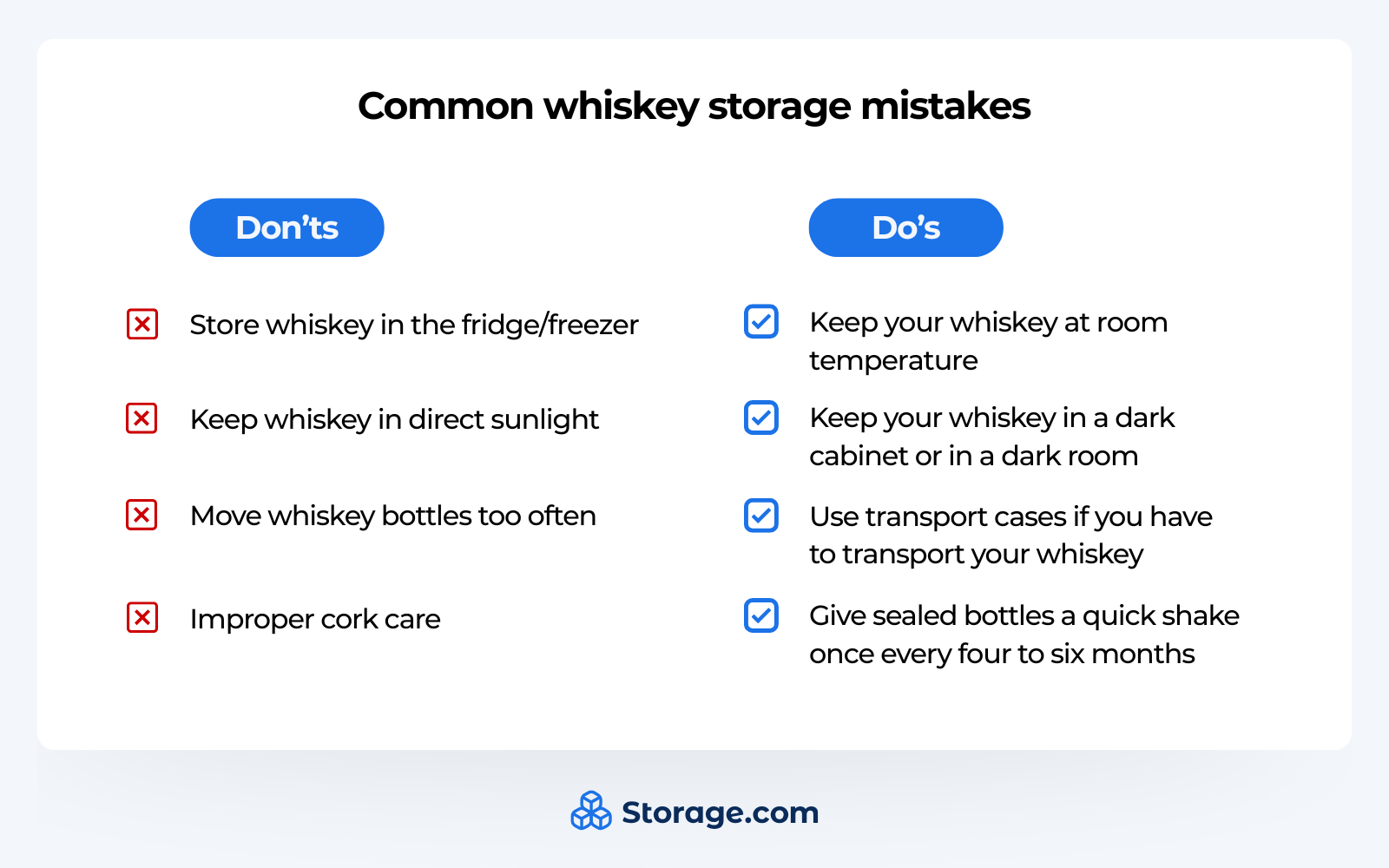
Knowing how to store whiskey collections properly includes the knowledge of what not to do. More than a few people have learned not to make the following common whiskey storage mistakes the hard way – by making them. We suggest reviewing these common storage errors and learning from others’ mistakes, so you don’t have to learn from your own!
Refrigerator Storage Problems
One of the most common whiskey storage mistakes is storing whiskey in the fridge or freezer. As we mentioned earlier, whiskey will expand and contract if it undergoes temperature fluctuations. What we didn’t mention is that whiskey is stored at room temperature from the time it’s bottled, throughout the shipping and distribution process, and at the liquor store.
The ideal whiskey storage temperature is between 59-68°F, and most liquor stores don’t keep their storage room much higher than that. That said, if you take that bottle home and throw it in your 40-degree fridge, you’re allowing the temps of the liquor to drop down a significant amount.
And if you put your fine whiskey in the freezer, the temperature fluctuation is even more drastic. The frigid whiskey will congeal, causing some of the compounds to separate. While the whiskey won’t lose its alcohol content, its flavor will decrease in potency.
There’s nothing wrong with enjoying a crisp and cold glass of bourbon, mind you. But putting the whole bottle in the fridge or freezer isn’t the way to go. Pour your spirit over some whiskey stones or an ice cube, or into a cold glass, to chill one serving at a time. Avoid chilling the whole bottle.
And the opposite is also true. When we say to keep your whiskey at room temperature, we mean between 59 and 70 degrees. Don’t keep your whiskey near the stove in the kitchen, for example, or by the fireplace or radiator. If you do the radiating heat will expand the liquor, separating those same flavorful compounds.
Direct Sunlight Exposure
Another common whiskey storage mistake is keeping your spirit collection in direct sunlight. UV rays and light exposure can not only cause unwanted changes in your whiskey’s color, but can also affect its taste quality.
Displaying your spirit collection on a shelf in a well-lit room might feel like a great way to impress and extend hospitality to your guests. That might be fine during the dinner party, but not when it comes to long-term whiskey storage.
We suggest keeping your whiskey in a dark cabinet, a tinted light-resistant whiskey display case, or in a dark room far away from sunlight exposure.
Frequent Moving and Handling
We talked earlier about how to store whiskey collections upright instead of on their side because, unlike wine, whiskey’s high alcohol content can corrode the cork. Well, the same goes for frequent moving and handling.
Another common mistake whiskey drinkers make is moving and handling their fancy bottles of whiskey so often that the liquor inside splashes up against the cork and degrades it. Cork corrosion not only lets air pass into the bottle, causing oxidation, but the eroded cork also flakes off into the whiskey, contaminating it with pieces of cork and impacting its flavor profile. ‘
If you have to transport your whiskey, use transport cases designed for liquor bottles, or put the bottles and keep them upright, so the liquor doesn’t splash up onto the cork.
Improper Cork Care
This last common whiskey storage mistake is more relevant to long-term whiskey storage for unopened bottles. A dry cork gets brittle, and a brittle cork can shrink, let air pass through, and oxidize your whiskey. Plus, a brittle cork can shed into your liquor just like a corroded cork can.
This may seem like a contradiction after reading the last section, but if you’re storing your whiskey for more than a year, you’ll actually want to give your bottle a shake every now and then to wet the cork and keep your bottle sealed.
We’re not saying to store your bottle sideways, or to shake them once a week – as we explained above, that will wear your whiskey out even faster than a dry cork will. But experts suggest giving your sealed whiskey bottles a quick shake, just enough to wet the cork, once every four to six months, or two to three times a year.
Whiskey Storage Ideas for How to Maintain Your Whiskey Storage System
Once you have your cool and dark closet, basement, or climate-controlled storage unit all set up as your whiskey storage room, you’ll want to implement some maintenance routines to keep your whiskey flavorful.
1. Regular temperature and humidity checks
Make sure that the room you’ve chosen as your whiskey storage space stays at a consistent temperature. You also have to keep your humidity levels between 40 and 70% at all times. We suggest a small climate-controlled storage unit, since the temperature and humidity levels are kept in a stable range.
2. Bottle inspection schedules
By now, you should know to store your whiskey collection in a way that keeps all your bottles upright. But you don’t want to set and forget them. Stop by your whiskey collection storage space once every four to six months and give the bottles a quick shake back and forth just to wet the cork and keep the seal intact. Don’t wet the cork more often than three times a year.
3. Stock rotation
If you’re managing a bar or restaurant, the goal should be to open as few bottles of each type of whiskey as possible. We suggest one bottle per bar. Follow the standard FIFO (first-in, first-out) rotation, keeping the newer cases of whiskey bottles behind/under the older cases, so you’re grabbing from the oldest case when you’re restocking your bar.
4. Signs of whiskey storage problems
If your storage space has fluctuating temperatures or humidity levels or UV ray exposure, the first thing you’ll notice is that the bottles that have been there the longest will change color. Unfortunately, the cause of the color change is molecular compound separation, and this impacts the flavor as well. Color change means you need a darker storage space with more consistent temperature and humidity control.
- Another sign of whiskey storage problems is chewed-up boxes. If you see teeth marks in your boxes, you may have a rodent infestation. Also, insects love to nest in cardboard, so check your boxes for pests on a regular basis and adjust your pest control accordingly.
- If you notice bottles or even cases of whiskey missing, you either have an inventory management issue that needs to be ironed out, or your whiskey collection is susceptible to theft.
Let’s take a look at how Storage.com can help you employ some whiskey storage ideas that will nip storage issues like pests, theft, light exposure, and humidity and temperature control in the bud before they damage your investment.
Whiskey Storage Ideas: How Storage.com Can Help
By now, you have a pretty good idea of how to store whiskey without compromising the integrity of its flavor and color, or allowing it to oxidize. In short, store your whiskey bottles upright in a cool, dark whiskey storage space with a consistent room temperature and humidity levels around 50%-55%.
Comparing the whiskey storage techniques outlined in this guide can weaken the flavor of your whiskey, and the difference between a $20 bottle and a $200 bottle will evaporate along with the whiskey flavor.
The best thing you can do to preserve your investment and whiskey collection is to create a dedicated whiskey storage space with no light exposure and an average temperature between 59 and 70 degrees.
But what if we have windows in every room of the home? And are we seriously supposed to keep our house’s resting temperature as low as 65 degrees even in the wintertime? How much control do we really have over the humidity levels, and how are we supposed to monitor them, never mind control them?
And what if your restaurant or bar storage rooms are musky and humid? How can you also protect your whiskey inventory from pests and theft if you’re not keeping it locked away in a humid storage closet?
Don’t worry, Storage.com is here to help.
Whether you’re looking to store your personal spirits collection in a small 5×5 storage unit, or you need a larger storage unit size for your restaurant or bar inventory, Storage.com lets you browse and compare self-storage units using amenity and size filters that isolate the storage facilities in your area with all the ideal whiskey storage features.
Just punch your zip code into our handy Storage.com search tool, and you’ll see what we mean. We’ll filter through the thousands of local storage facilities for you, making it easy to find the storage unit that best fits your specific whiskey storage needs.
Again, for whiskey storage, we suggest a storage unit with climate control, which also controls humidity monitoring and management. But you decide if features like electricity, alarms, 24-hour access, drive-up access, or security cameras are also important. Once you know what you want, Storage.com makes the process quick and painless. All you have to do is choose a storage unit and your move-in date, and we’ll take care of the rest. And if you have any questions about commercial or business storage, this whiskey storage guide didn’t answer, feel free to ask. Our storage representatives are just a phone call away!
